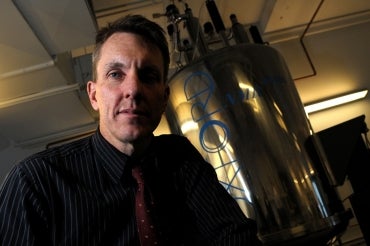Good Things Come in Pairs: U of T research shows enzymatic partners drive chemical reactions

Published: February 24, 2017
New research from U of T suggests that when it comes to chemistry, good things come in pairs.
Nature tends to package many enzymes as pairs or dimers and in many cases the dimeric enzymes exhibit cooperatively, that is they do not bind more than one substrate molecule at the same time.
Using X-ray crystallography and nuclear magnetic resonance, the team – led by co-authors U of T professor Emil Pai and U of T Mississauga professor Scott Prosser – captured high-resolution snapshots of the paired enzymes during various stages of catalysis.
 “The research advances fundamental concepts regarding the role of enzyme dynamics in catalysis,” says Prosser. “By understanding how binding events regulate enzyme flexibility, we can better design drugs to affect changes on properties of target molecules in fighting disease.”
“The research advances fundamental concepts regarding the role of enzyme dynamics in catalysis,” says Prosser. “By understanding how binding events regulate enzyme flexibility, we can better design drugs to affect changes on properties of target molecules in fighting disease.”
The findings highlight how paired or “dimeric” enzymes use their empty “seat” to drive a chemical reaction on their occupied half, meaning that after binding the first substrate in the dimer, binding and turnover of the second substrate becomes even faster.
The findings appear in a recent issue of the journal Science.
Enzymes, of which the vast majority are proteins, speed up chemical reactions in living organisms, without themselves being altered in the process.
Prosser and his colleagues at U of T Mississauga recently uncovered another reason for this pairing, in their study of a bacterial enzyme, fluoroacetate dehalogenase. Namely, the empty seat of the dimer becomes dynamic upon binding to the substrate and helps drive forward the reaction. The role of this paired enzyme is to pry away a fluorine atom from an otherwise potent and lethal pesticide, fluoroacetate. This is no small feat – the carbon-fluorine bond is one of the strongest chemical bonds in nature.
As an aside, some plants are able to make this poison to protect themselves from grazing herbivores, who don’t have this enzyme and therefore – like humans – could be killed by this poison.
The empty half of the pair appears to still do a fair share of the work in accomplishing this reaction. As the poison binds to the dimer, the empty half sheds water molecules and become more dynamic at the same time, making the reaction more spontaneous. If the enzyme were to suddenly jiggle and lose water molecules in the bound half of the dimer this might spell disaster for the actual bond breaking chemical step – so the empty half of the dimer does the dirty work. The enzyme also prevents binding of a second molecule while it is focused on catalysis of the first molecule.
The team also found that water molecules aren’t just used by the enzyme as “ballast” to drive the reaction. Very subtle networks of these water molecules, appearing as constellations, distinguish the enzyme at each step along the reaction pathway.
As crystallographic resolution improves, scientists may find that these bound water networks are more involved in protein function than previously imagined.



